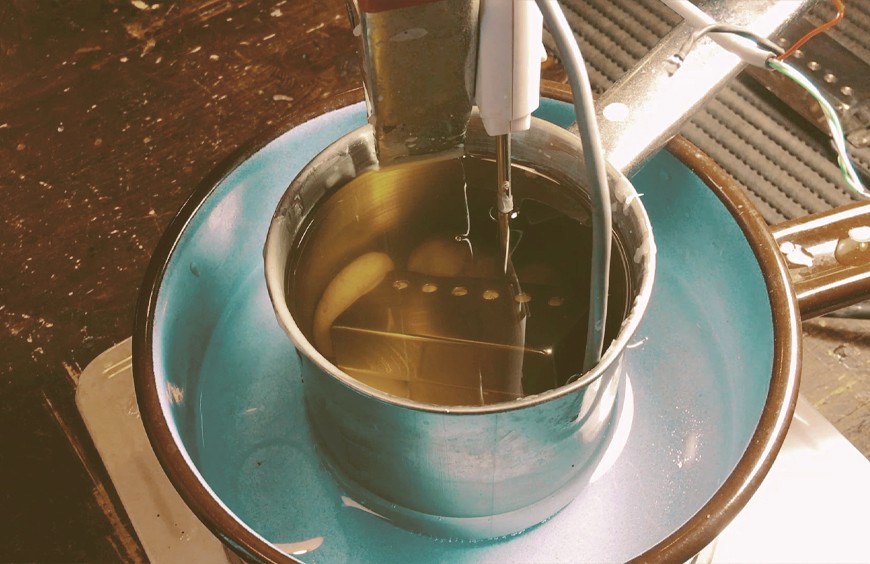Wax potting pickups
In this new episode of our Youtube series "On the bench", we teach you how to wax pot your pickups.
WHY DO WE WAX THE PICKUPS?
Pickups are made up of different parts and elements, such as copper winding, plates, covers or magnets. The winding, for example, can have small air spaces and some sections of this coil can be loose and vibrate due to the sound waves from our amp while we're playing. This can also happen with covers. If a cover is poorly soldered or there is too much air between it and the pickup, it could also cause unwanted vibration. When this occurs, the pickup causes feedback and this can occur both at high gain and, in more severe cases, even at low gain and distortion-free settings. This makes it almost impossible to play the guitar or, at the very least, quite unpleasant. When this problem appears, we say that the pickup is microphonic or that we have a microphonic pickup, that is, the pickup behaves as a microphone would. In fact, we can check it by talking close to it and we will see how our voice is emitted through the amplifier. To avoid this problem, we must wax the pickup.
WHEN SHOULD I DO IT?
Basically, there are three scenarios where it would be useful or even necessary to wax the pickups:
1. If you are building pickups, waxing them will help prevent this problem from appearing in the future.
2. If you install some covers, for example in a humbucker, it is convenient that you wax them after installation.
3. If any pickup becomes microphonic, waxing it may be the solution.
Also keep in mind that, in the case of covered pickups, the pickup might be microphonic due to a bad soldering of the cover to the pickup. If the cover is not properly attached to the pickup, no matter how much we wax it, it is likely that the cover will continue to vibrate and therefore we will not solve the problem. Check the soldering points and re-solder them if necessary, before waxing the pickup.
WHAT DO I NEED?
To wax a pickup, you do not need very specific or expensive tools, so you can consider doing it at home by following the steps that we are going to show you.
Recipe:
- 100% neutral paraffin (block or granulated)
* An alternative recipe is to add beeswax in a 80/20 ratio.
Tools:
- A kitchen saucepan in which the pickup fits
- A larger saucepan to be able to put the first one inside
- A kitchen thermometer
- Kitchen/shop paper
- A kitchen (if possible electric)
- Clean pebbles (gardening type)
Safety advice:
- Do it in a spacious and well ventilated place
- Do not work with a flame nearby
The fumes emitted by the paraffin when heated are quite flammable, so it is advisable not to have a fire nearby and to be in a large and well-ventilated space.
HOW DO I DO IT?
The waxing process is actually quite simple. It involves preparing a water bath to heat the paraffin and bring it to a liquid state. To achieve this, we must bring it to a temperature of 60-65ºC. It is important to control the temperature with the thermometer since, with a lower temperature, we will not be able to make the paraffin liquid but, on the contrary, if it reaches a very high temperature, we could cause damage to the pickups since the heat could melt some of the internal parts. Once the paraffin is liquid, we can add the pebbles, creating a blanket at the bottom of the saucepan. This way, the pickup will not come into direct contact with the bottom of the saucepan, which is usually the hottest part and is usually at a higher temperature than the paraffin itself. This will prevent any kind of internal damage to the pickup. We have everything ready and we can now dip the pickup. We will see that when submerged, the pickup turns white. This is due to the difference in temperature, since the pickup is much colder than the paraffin. The paraffin that comes into contact with the pickup cools down and returns to a solid or semi-solid state and assumes its original white color. Don't worry, you will see that in a few seconds the paraffin gradually returns to its liquid state and the white color on the pickup disappears.
Now you will see that the tablet is expelling air in the form of small bubbles. That's normal, in fact, it's what we expect. The air inside the pickup is being replaced by liquid paraffin, which is precisely what we want. Once we remove the pickup, the paraffin will quickly enter a solid state when it cools down and these holes will be solidified and sealed, thus avoiding the vibrations that cause microphonics. Wait until the bubbles stop coming out and all the air has been expelled. There is no exact time, but it is usually a process of about 10 minutes. Then carefully remove the pickup and place it on absorbent paper. Use the paper to carefully clean the pickup and remove any residual paraffin that is on it. And ready! You have already waxed your pickup. Let it cool completely, install it on your guitar and check that there are no problems.
This is a summary of the process, if you want to see it in more detail, don't miss the new episode of "On the bench" on our YouTube channel. And don't forget to subscribe!


Leave a Reply Cancel Reply